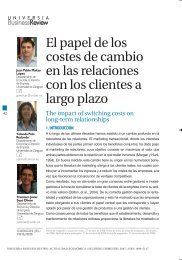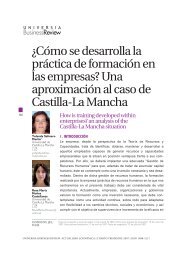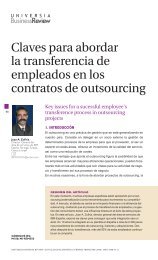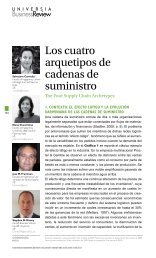ubr-universia-business-review
ubr-universia-business-review
ubr-universia-business-review
- No tags were found...
Create successful ePaper yourself
Turn your PDF publications into a flip-book with our unique Google optimized e-Paper software.
Transparency in social disclosure in financial institutions through spanish<br />
csr reports in the context of crisis<br />
88<br />
2.1. Classification of content disclosed<br />
The information disclosed in the reports can be classified based on<br />
the relationship the entity has with different interest groups (AECA,<br />
2004). The categories of information identified can therefore refer to<br />
primary and secondary stakeholders, according to the content affecting<br />
some or others.<br />
- The first category includes groups which hold a contractual<br />
relationship with the entity and are involved in the day-to-day<br />
activity of the company (financial intermediation), with rights<br />
formally recognised by the company which results in them<br />
being called stakeholders or direct agents; in the specific case<br />
of the study this refers to customers and employees.<br />
- The second category includes those who have come to be<br />
known as secondary or indirect stakeholders, whose relationship<br />
with the company is based more on ethical than legal obligations.<br />
Although they are affected by the action of the entity,<br />
their relationship is based more on a tacit contract and they are<br />
not directly involved in the company’s activity. Basically, this<br />
category covers information content referring to the society<br />
and the environment. Diagram 1 provides a graphic representation<br />
of how these groups are classified.<br />
Diagram 1. Stakeholders levels<br />
SOCIETY<br />
CUSTOMERS<br />
ORGANIZATION<br />
Source: Own work<br />
EMPLOYEES<br />
ENVIRONMENT<br />
2.2. Population being studied<br />
The total population on which this is based consists of FIs which<br />
operate in Spain. These are divided based on their legal status into<br />
Banks, Savings Banks (SBs) and Credit Unions (CUs). Banco de Es-<br />
UNIVERSIA BUSINESS REVIEW | SEGUNDO trimestre 2013 | ISSN: 1698-5117
















